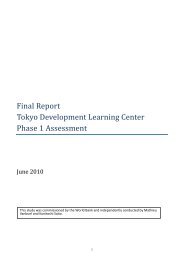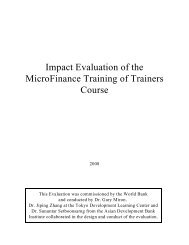Session 1 summary.pdf - Tokyo Development Learning Center
Session 1 summary.pdf - Tokyo Development Learning Center
Session 1 summary.pdf - Tokyo Development Learning Center
You also want an ePaper? Increase the reach of your titles
YUMPU automatically turns print PDFs into web optimized ePapers that Google loves.
Disaster Risk Management in East Asia and the Pacific<br />
Distance <strong>Learning</strong> Seminar Series 2011<br />
<strong>Session</strong> 1 (June 1, 2011): “Making Women's Voices Count in Disaster Risk Reduction Programs”<br />
Presenters:<br />
Hanindya Artati, Technical Assistance Expert, Community Based Housing Reconstruction<br />
Project (REKOMPAK), Yogyakarta, Indonesia (hanindya.artati@gmail.com)<br />
Adelina Kamal, Head, Disaster Management & Humanitarian Assistance Division, Cross‐<br />
Sectoral Cooperation Directorate, ASEAN Socio‐Cultural Community (ASCC) Department, The<br />
ASEAN Secretariat, Jakarta, Indonesia (lina@asean.org)<br />
Doracie Zoleta‐Nantes, PhD, Fellow, Resource Management in Asia‐Pacific Program,<br />
Crawford School of Economics and Government, Australian National University of Asia and<br />
the Pacific, Canberra, Australia (doracie.zoleta‐nantes@anu.edu.au)<br />
Main Moderator:<br />
Helene Carlsson Rex, Senior Social <strong>Development</strong> and Gender Specialist, World Bank,<br />
Vientiane Country Office, Laos<br />
Key Topics Discussed:<br />
1. Women’s Roles in Different Phases of Disaster Risk Management (DRM)<br />
2. Challenges in Mainstreaming Gender in DRM Programs<br />
3. Tools for Mainstreaming Gender in Disaster Risk Reduction (DRR)<br />
Executive Summary:<br />
This seminar aims to improve the understanding of the importance of gender issues in Disaster Risk<br />
Management (DRM) and to share good practices demonstrating how gender aspects can be<br />
successfully integrated into DRM operations. The key points highlighted in the session are as follows:<br />
‣ Although women are traditionally being portrayed as vulnerable disaster victims, they constitute<br />
a vital part in disaster prevention, mitigation, preparation, response, and recovery efforts.<br />
Women, if given equal opportunities, are capable of performing several different DRM roles.<br />
‣ As DRM still remains a male‐dominated field, there are various challenges in mainstreaming<br />
gender in DRM in the East Asia and the Pacific region. Although policy frameworks for gender<br />
equality are growing stronger, there are still significant gaps between intentions and actual<br />
practice.<br />
‣ Recognizing the importance of gender‐informed actions, a number of guidelines, tools, and<br />
performance indicators for policymakers and practitioners have been developed and<br />
disseminated to raise awareness of gender balanced approaches for DRM.<br />
‣ Mainstreaming gender perspectives in DRM still requires considerable effort on all levels, from<br />
local to global. Although there are many examples of the involvement of women into the DRM<br />
informal community, women are still largely excluded from important tasks such as formal<br />
planning and decision‐making. Much still needs to be done to upgrade the skills and knowledge<br />
of women in project planning, management, implementation, and monitoring in order to<br />
enhance the quantity and quality of women’s involvement in DRM. Entry points for amplifying<br />
women’s voice in disaster risk reduction should also be constantly explored.<br />
1
Summary:<br />
1. Women’s Roles in Different Phases of Disaster Risk Management<br />
While it is widely agreed that women are disproportionately affected by natural disasters as a result<br />
of their socio‐economic and political positions in society, this is not the complete picture. Women<br />
are not the helpless victims that they are traditionally being portrayed as. Women can and do<br />
provide meaningful contributions in disaster prevention, mitigation, preparedness, response, and<br />
recovery efforts.<br />
<strong>Learning</strong> from the earthquake that hit Yogyakarta on May 27, 2006 and from the Mt. Merapi<br />
volcanic eruption on October 26, 2010, women have valuable knowledge, skills, and experience that<br />
are very helpful in addressing or managing disaster risks. The view that they are only wong wingking<br />
(people working behind the scene whose only roles are to give birth and perform household chores)<br />
definitely needs to be changed in order to engage women more actively in disaster risk reduction.<br />
For example, after the earthquake in Yogyakarta, women were involved as humanitarian workers<br />
helping survivors, as caregivers for children and the elderly, as caretakers of family assets and<br />
valuables, as supervisors and budget managers during house reconstruction, as designers who<br />
helped plan the house interior to minimize hazards, and as safety wardens for their family members.<br />
On another occasion, during the Mt. Merapi eruption, women became logistics volunteers in relief<br />
goods and medical supply distribution, and they also helped to organize evacuation shelters. At the<br />
disaster recovery stage, women continued the activities at the shelters by organizing early childhood<br />
education and communal farming activities.<br />
The Community‐based Settlement Rehabilitation and Reconstruction (REKOMPAK) is one of<br />
Indonesia’s programs in post‐disaster housing and settlement reconstruction which include disaster<br />
mitigation using a community empowerment approach. Women are involved in both the<br />
formulation of the Community Settlement Plan and implementation of the housing and community<br />
infrastructure reconstruction projects. These activities show that women possess the competency,<br />
willingness, and time to actively participate in rebuilding their village.<br />
Women, if given equal opportunities, can perform multi‐functional roles well as participants,<br />
managers, decision makers, and leaders in the field of DRR. Women can perform important tasks in<br />
building a culture of disaster preparedness, particularly at the community level. In the end, utilizing<br />
the combined efforts of men and women will hopefully lead to more effective DRM initiatives.<br />
2. Challenges in Mainstreaming Gender in Disaster Risk Management Programs<br />
The Hyogo Framework for Action (HFA) adopted by 168 countries in 2005 presents a strong<br />
mandate: A gender perspective should be integrated into all disaster risk management policies,<br />
plans, and decision‐making processes, including those related to risk assessment, early warning,<br />
information management, and education and training.<br />
However, there are various challenges in mainstreaming gender in DRM in East Asia and the Pacific.<br />
These include several factors that aggravate gender disparities during times of disaster, such as<br />
cultural expectations on women’s traditional caregiver role, limited livelihood opportunities and low<br />
income, low levels of education and limited educational opportunities, limited access to health<br />
services, and limited or no participation in infrastructure planning. DRM remains a male‐dominated<br />
field and there are an insufficient number of women that hold leadership roles in such agencies.<br />
2
Established disaster responses tend to primarily address men’s concerns and not those of women.<br />
Additionally, there is gender‐washing in project implementation due to male officials’ lack of<br />
knowledge and expertise on addressing gender issues.<br />
Women typically lack equal representation in DRM platforms. For example, one of the presenters,<br />
Adelina Kamal, is the only woman out of the nine members of the ASEAN‐led Tripartite Core Group,<br />
which coordinated the post‐Nargis response and recovery in Myanmar. There are many reasons for<br />
the lack of equal representations. Women often face entrenched societal barriers to participation<br />
resulting from views within the government and community that DRM is solely men’s business.<br />
Although regulatory and policy framework for gender equality is growing stronger, there are still<br />
significant gaps between what exists on paper and in practice. Another frequently heard view is that<br />
it is difficult enough to get DRM onto the policy/program agenda and that gender would further<br />
complicate things. Furthermore, there is a shortage of clear guidelines on how to include gender<br />
concerns during actual implementation of programs and projects. Moreover, there is a lack of<br />
government funding and commitment for the continuation of gender‐considerate DRM after the<br />
completion of donor‐supported programs. Finally, gender disaggregated DRM data are also very<br />
limited although work is now being done to deal with this problem. Addressing all these issues and<br />
challenges will help in building and enhancing the capacities of professional organizations,<br />
communities and relevant national and local institutions to enable mainstreaming gender in DRM.<br />
3. Tools for Mainstreaming Gender in Disaster Risk Reduction<br />
Although it is now recognized that gender perspective is essential to Disaster Risk Reduction (DRR),<br />
so far only very few concrete steps have been taken to mainstream gender into related policies and<br />
programs. Practitioners know why they should do it, but don’t always know how. This is not because<br />
the task is inherently difficult but because there is not enough precedent guidance and practical<br />
understanding. Therefore, user‐friendly recommendations, guidance, and tools on how to<br />
institutionalize gender‐sensitive risk assessments, implement gender‐sensitive early warning<br />
systems, and use gender‐sensitive indicators to monitor gender mainstreaming progress are<br />
essential to increasing the voice of women and the visibility of their roles in and contributions to<br />
DRR in the region.<br />
Important tools and strategies include (1) mainstreaming gender in DRM institutions and<br />
organizations, (2) developing gender‐sensitive DRM policies and programs, (3) using gender analysis<br />
tools to review, develop, and refine program proposals, (4) increasing representation of women in<br />
DRM decision making, (5) ensuring that policies and programs are informed by gender analysis and<br />
gender differentiated data, and (6) establishing targets for women involvement, HR policies,<br />
budgets, and trainings provided.<br />
The World Bank and the rest of the donor community should advocate gender to be implicitly<br />
considered in key support areas (e.g. governance, social inclusion, natural resource management) as<br />
well as incorporate gender dimensions in project objectives and key performance indicators,<br />
components, beneficiaries, institutional and implementation arrangements.<br />
Moreover, in making women’s voices count, as learned in the post‐Nargis humanitarian work<br />
performed in Myanmar, the following areas are crucial: leadership and effective coordination, access<br />
to information collection, consultative process, and assessment and monitoring at all stages. In the<br />
relief and recovery efforts, women were part of the targeted key informants in focused groups<br />
discussions, case studies, and observation checklists. These included potentially vulnerable groups,<br />
such as female‐headed households and young women. Specific questions targeted to women were<br />
3
included as part of the questionnaires. In the case of Social Impact Monitoring, there was an equal<br />
ratio of male and female respondents. These efforts were all made to apply a gender balanced<br />
approach to DRM with the aim to listen more intently to previously ignored women’s voices.<br />
4
Further Information:<br />
Organizations:<br />
• Gender and Disaster Network<br />
http://www.gdnonline.org<br />
The Gender and Disaster Network is the first web presence to advocate for gender mainstreaming in<br />
disaster risk reduction using the Internet. It is an international forum for discussion, networking, and<br />
information exchange including topical bibliographies and reports on applied projects or research in<br />
progress, book reviews, current information about relevant conferences and other events, as well as<br />
a bulletin board for employment, scholarship or funding opportunities.<br />
• Department of Gender, Women and Health (GWH), World Health Organization<br />
http://www.who.int/gender/other_health/disasters/en/<br />
WHO is committed to ensuring that gender considerations are adequately addressed in all of its<br />
relief, rehabilitation, and reconstruction activities. Information and links on gender and disasters are<br />
available on GWH’s webpages.<br />
• Humanitarian Reform<br />
http://www.humanitarianreform.org/Default.aspx?tabid=453<br />
The link leads to a compilation of information related to gender and DRM, including humanitarian<br />
action.<br />
Publications:<br />
• Making Disaster Risk Reduction Gender‐Sensitive: Policy and Practical Guidelines<br />
Publishers: UNISDR, UNDP, and IUCN (2009)<br />
http://www.preventionweb.net/files/9922_MakingDisasterRiskReductionGenderSe.<strong>pdf</strong><br />
• Stories from the Pacific: The Gendered Dimensions of Disaster Risk Management and Adaptation<br />
to Climate Change<br />
Publishers: AusAid, Government of Australia and UNDP (2009)<br />
http://www.undppc.org.fj/_resources/article/files/UNDP%20PC%20Climate%20Change.<strong>pdf</strong><br />
• Gender Sensitive Disaster Management: A Toolkit for Practitioners<br />
Publisher: Earthworm Books for Oxfam America and NANBAN Trust (2008)<br />
http://www.preventionweb.net/files/7792_GndersensitivedisastermanagementToolkit.<strong>pdf</strong><br />
• Women as Equal Partners: Gender Dimensions of Disaster Risk Management Programme<br />
Publishers: Government of India and UNDP (2008)<br />
http://reliefweb.int/node/24662<br />
• Gender Perspective: Working Together for Disaster Risk Reduction<br />
Publisher: UNISDR (2007)<br />
http://www.unisdr.org/eng/about_isdr/isdr‐publications/09‐gender‐good‐practices/gender‐goodpractices.<strong>pdf</strong><br />
5

















